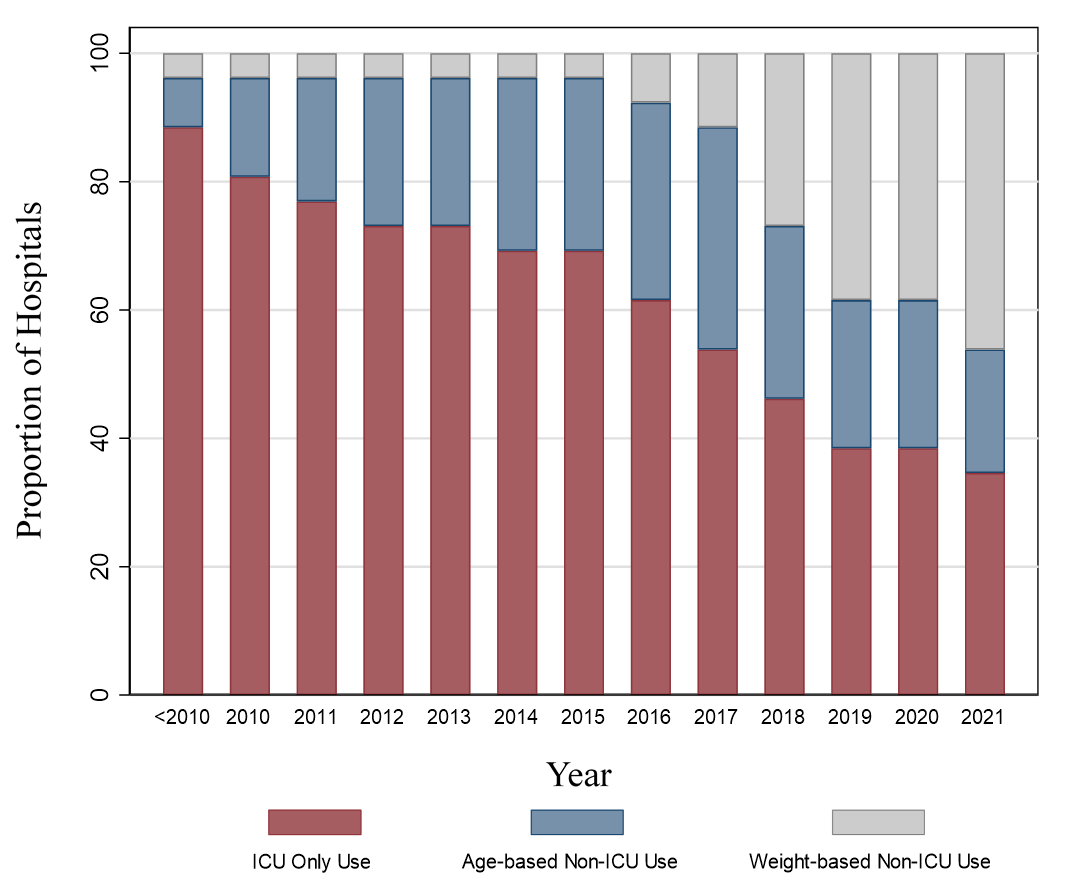Hospital Medicine: Clinical
Category: Abstract Submission
Hospital Medicine: Clinical - Bronchiolitis/HFNC and Newborn Care
133 - The current state of high-flow nasal cannula protocols at children’s hospitals
Monday, April 25, 2022
3:30 PM - 6:00 PM US MT
Poster Number: 133
Publication Number: 133.415
Publication Number: 133.415
Robert Willer, University of Utah, Salt Lake City, UT, United States; Patrick Brady, Cincinnati Children's Hospital Medical Center, Cincinnati, OH, United States; Amy Tyler, University of Colorado School of Medicine, Aurora, CO, United States; Jennifer D. Treasure, Cincinnati Children's Hospital Medical Center, Cincinnati, OH, United States; Eric Coon, University of Utah, Salt Lake City, UT, United States

Robert Willer, DO
Assistant Professor
University of Utah
Salt Lake City, Utah, United States
Presenting Author(s)
Background: Studies examining high flow nasal cannula (HFNC) protocols for use outside the intensive care unit (non-ICU) have come to conflicting conclusions about their effectiveness for patients with bronchiolitis. The conflict in findings may be related to different maximum flow rates in protocols. Maximum flow rates for early non-ICU HFNC protocols were age-based (e.g., 6 liters per minute maximum flow for infants < 12 months), but recent randomized trials have utilized weight-based (e.g., 2 liters per kilogram per minute) maximum flow rates. The extent to which weight-based flow rates have since been adopted for non-ICU HFNC protocols is unknown.
Objective: To describe the current state of non-ICU HFNC protocols at children’s hospitals.
Design/Methods: We conducted a cross-sectional study at the 49 hospitals currently contributing data to the Pediatric Health Information Systems (PHIS) database. First, we designed a survey with the purpose of describing current HFNC protocol characteristics, such as inclusion and exclusion criteria, maximum flow rates and fraction of inspired oxygen allowed, and dates of key changes to the protocol. Next, we piloted the survey by e-mailing contacts at 4 different institutions and made changes based on feedback received. We then distributed the survey to PHIS hospitalists who were identified from: 1) our prior national HFNC survey or 2) membership in a national HFNC improvement collaborative.
Results: We received survey responses from 28/49 (57%) hospitals. Up until 2016, non-ICU HFNC protocols were uncommon at children’s hospitals (Figure). However, since 2016 there has been a steady increase in adoption of non-ICU HFNC protocols, with 68% of children’s hospitals reporting non-ICU HFNC protocols in 2021. Weight-based protocols were quite uncommon (8% of hospitals) in 2016, but as of 2021, 71% of non-ICU HFNC protocols are weight-based. The median maximum flow rate for weight-based HFNC protocols is 20 liters per minute (Table), but hospitals reported a wide-range of maximum flow rates (15-60 liters per minute). These flow rates contrasted with age-based protocols, for which previously reported peak flow rates were 4-10 liters per minute. Notably, 31% of non-ICU HFNC protocols are being applied to patients with diagnoses beyond bronchiolitis.Conclusion(s): Most children’s hospitals have adopted non-ICU HFNC protocols, the majority of which are now using weight-based maximum flow rates. Whether the increased maximum flow rates allowed by these newer protocols are improving patient outcomes requires further investigation.
Figure Bar chart showing the proportion of hospitals (n=26) without a non-ICU HFNC protocol (red), with a non-ICU age-based HFNC protocol (blue), and with a non-ICU weight-based HFNC protocol (gray) across time.
Bar chart showing the proportion of hospitals (n=26) without a non-ICU HFNC protocol (red), with a non-ICU age-based HFNC protocol (blue), and with a non-ICU weight-based HFNC protocol (gray) across time.
Table Characteristics of hospitals weight-based HFNC Protocol for ward use.
Characteristics of hospitals weight-based HFNC Protocol for ward use.
1Categories are not mutually exclusive.
Objective: To describe the current state of non-ICU HFNC protocols at children’s hospitals.
Design/Methods: We conducted a cross-sectional study at the 49 hospitals currently contributing data to the Pediatric Health Information Systems (PHIS) database. First, we designed a survey with the purpose of describing current HFNC protocol characteristics, such as inclusion and exclusion criteria, maximum flow rates and fraction of inspired oxygen allowed, and dates of key changes to the protocol. Next, we piloted the survey by e-mailing contacts at 4 different institutions and made changes based on feedback received. We then distributed the survey to PHIS hospitalists who were identified from: 1) our prior national HFNC survey or 2) membership in a national HFNC improvement collaborative.
Results: We received survey responses from 28/49 (57%) hospitals. Up until 2016, non-ICU HFNC protocols were uncommon at children’s hospitals (Figure). However, since 2016 there has been a steady increase in adoption of non-ICU HFNC protocols, with 68% of children’s hospitals reporting non-ICU HFNC protocols in 2021. Weight-based protocols were quite uncommon (8% of hospitals) in 2016, but as of 2021, 71% of non-ICU HFNC protocols are weight-based. The median maximum flow rate for weight-based HFNC protocols is 20 liters per minute (Table), but hospitals reported a wide-range of maximum flow rates (15-60 liters per minute). These flow rates contrasted with age-based protocols, for which previously reported peak flow rates were 4-10 liters per minute. Notably, 31% of non-ICU HFNC protocols are being applied to patients with diagnoses beyond bronchiolitis.Conclusion(s): Most children’s hospitals have adopted non-ICU HFNC protocols, the majority of which are now using weight-based maximum flow rates. Whether the increased maximum flow rates allowed by these newer protocols are improving patient outcomes requires further investigation.
Figure
 Bar chart showing the proportion of hospitals (n=26) without a non-ICU HFNC protocol (red), with a non-ICU age-based HFNC protocol (blue), and with a non-ICU weight-based HFNC protocol (gray) across time.
Bar chart showing the proportion of hospitals (n=26) without a non-ICU HFNC protocol (red), with a non-ICU age-based HFNC protocol (blue), and with a non-ICU weight-based HFNC protocol (gray) across time.Table
 Characteristics of hospitals weight-based HFNC Protocol for ward use.
Characteristics of hospitals weight-based HFNC Protocol for ward use.1Categories are not mutually exclusive.
